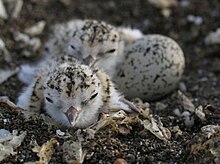User:Lisaswriting303/sandbox
Plants and Animals
[edit]Plants
[edit]With the importance of stable native plant species to the success of the dunes ecosystem, several native plants and plant groups have been identified as crucial and are part of active management and conservation efforts. These plants include Red Fescue, Port Orford Cedar, Evergreen Huckleberry, Seashore Bluegrass, Shore Pine, Hairy Manzanita, Bearberry, Bog Blueberry, Tufted Hairgrass, Slough Sedge, Sitka Spruce, and Skunk Cabbage.[1]
Original native plant species have been drastically reduced over the years due to planting of European beachgrass, Scot’s broom and shore pine for sand stabilization that occurred from 1910 through 1979.[2]
Birds
[edit]Many species of birds live in the habitats available in the Oregon Dunes National Recreation Area. The South Jetty Area includes beach, marsh and coastal wetlands where the Tundra Swan, the Marsh Wren, the Canada Goose, the Yellow-rumped Warbler, the Red-tailed Hawk, the Sanderling, the Long-billed Curlew, the Dunlin, and the Least Sandpiper make their home. The Great Blue Heron, the American Bittern, the Green Heron, the Virginia Rail, the Cinnamon Teal, the Common Yellowthroat, the Common Merganser, the Belted Kingfisher, the Snowy Plover, the Bald Eagle, and the Osprey live along the Siticoos area by the Waxmyrtle trail. The Eel Creek area includes many shore pines, and provides shelter to the Pine Siskin, the Chestnut-backed Chickadee, the Swainson’s Thrush, the Wrentit, the Northern Flickers, the Red Crossbill, the Olive-sided Flycatcher, and Anna’s Hummingbird. The White-tailed Kite, the Northern Harrier, the Violet-green Swallow, the Downy Woodpecker, the Orange Crowned Warbler, the Yellow Warbler, the Black-throated Gray Warbler, the Townsend’s Warbler, the Hermit Warbler, the Great Horned Owl, and the Great Egret are located in the Horsefalls area.[3]

The Western Snowy Plover uses the Oregon Dunes National Recreation Area as a nesting site. In 1993, the Western Snowy Plover was identified as a “threatened” species by the US Fish and Wildlife Service with only 68 birds in Oregon. Agencies created a multi-pronged approach to protect the plovers and revitalize their numbers. Techniques included restoring the plover habitat along the sand dunes by removing invasive beach grasses and maintaining the appropriate structure that were optimal for nest building, protection of nesting sites through education, signage, beach restrictions during the nesting season from March 15 through September 15, and law enforcement when necessary. Removal of predators, and accurate population monitoring were other techniques employed. As of 2012, the number of Western Snowy Plovers has increased to 403 birds.[4]
 | This is a user sandbox of Lisaswriting303. You can use it for testing or practicing edits. This is not the sandbox where you should draft your assigned article for a dashboard.wikiedu.org course. To find the right sandbox for your assignment, visit your Dashboard course page and follow the Sandbox Draft link for your assigned article in the My Articles section. |
- ^ Christy, John A., "Rare Plant Associations, Oregon Dunes National Recreation Area, Sutton Recreation Area, and Heceta Sand Dunes ACEC/ONA" (2013). Institute for Natural Resources Publications. 7.
- ^ Stein, Marty (June 12, 2015). "Survey for sand dune endemic species in the Oregon Dunes National Recreation Area" (PDF). Interagency Special Status Species Program FY 2014 Inventory and Conservation Planning Project.
- ^ "Birds of the Oregon Dunes National Recreation Area". Retrieved November 6, 2018.
- ^ Todd, Laura; Elbert, Daniel (January 2014). "Western Snowy Plover in Oregon: Community Creates Recovery". Northwest Science. 88 (1): 58–60. doi:10.3955/046.088.0112. ISSN 0029-344X. S2CID 85724795.
